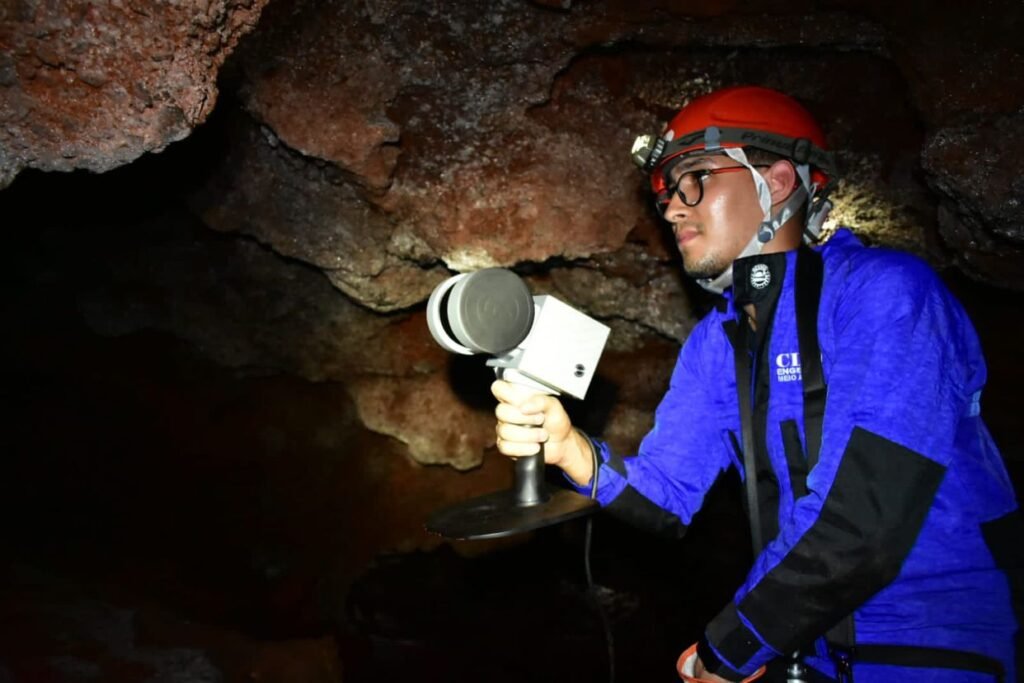Speleology
Fundamental Part of Environmental Permitting for Projects in Areas with Potential Cave Occurrence.
Speleology is the science that studies caves, grottos, and other subterranean environments, being essential for risk and opportunity analysis in Environmental Permitting. Understanding the complexities of these karst landscapes, which can include underground rivers, rare speleothems, and specific fauna, is vital to ensure a robust and sustainable environmental permitting process.
Learn more about our solutions and how we can help you

Environmental Feasibility Analysis of the Project
The Environmental Feasibility Analysis of the Project is a preliminary stage to Environmental Permitting. It involves consulting publicly available databases on the occurrences of natural underground cavities and speleological and geological potential. In parallel, a landscape interpretation is conducted using accessible images to detail this potential. Based on the results obtained, a legal analysis is performed considering permissive, restrictive, or prohibitive aspects according to the projected level of permitting at municipal, state, or federal levels.
Prospection and Analysis of Speleological Potential
During the Prospection and Analysis of Speleological Potential stage, studies are initiated to refine the potential occurrence of cavities, define the necessary survey density, and conduct field activities. In the field, a delineated area is traversed to identify and characterize speleological features. Various landscape attributes are mapped and integrated to ascertain the local speleological potential, determining the detailed survey density requirements. Specialized teams traverse the target area, aiming to meet the minimum survey density defined in the potential analysis to sample and confirm the real speleological potential and identify and characterize speleological features.


Speleotopography
Speleotopography involves mapping and calculating the dimensions of speleological features. Currently, there are two available methods: conventional and three-dimensional. The conventional method requires the team's presence on-site to take measurements and plot them for later digitization, where calculations are applied to obtain the feature's dimensions. The three-dimensional method requires using specific technological equipment for field capture, with data processed subsequently. This data is important for the project's dimensioning, and the Speleotopography stage can be executed alongside Prospection.
Delimitation of Specific Influence Area
In specific cases, depending on the project and its proximity, technical analysis for the Delimitation of a Specific Influence Area of natural underground cavities allows for detailing based on socio-environmental factors. This involves analyzing local environmental attributes to refine a minimum necessary area for maintaining and preserving the feature, different from the 250m radius defined by legislation. Physical, biological, sociocultural, and prehistoric factors are necessary approaches, providing more parameters than the arbitrary 250m radius initially defined as the influence area. Depending on the case, the project can adjust to a new delimitation.


Environmental Impact Analysis
Considering the scenarios of each stage of a given project, the scope involves analyzing the forecast of its emissions and potential alterations to the speleological heritage. In the absence of impacts or potential impacts, it is possible to reconcile the project's development near a speleological heritage, accompanied by monitoring actions and environmental improvements. In case of identifying irreversible negative impacts, it becomes mandatory to analyze the relevance to define how to manage the future condition of natural underground cavities.
Speleological Relevance
The analysis of Speleological Relevance applies to cases where natural underground cavities become targets of real irreversible negative impacts. It involves applying a legally prescribed method through physical, biological, and historical-cultural analyses on local and regional scales, determining the cavity's relevance level: maximum, high, medium, or low. Each relevance level implies a specific type of preservation and compensation management. It is an excellent way to conduct the strategic planning of a long-term project, along with potential expansions and limitations due to locational rigidity.


Speleological Compensation
Compensation arises from the need, evaluated in environmental permitting processes, for the project to cause real irreversible negative impacts on a cavity. Thus, the compensation will depend on the relevance level that the cavity to be impacted possesses. Each relevance level prevents or restricts the forms of compensation. That is, there is a relevance level that does not allow impacts and compensations; a level that allows compensation with other cavities with similar characteristics; levels that allow other forms of compensation; and a level that does not require compensation. Therefore, depending on each case, it is necessary to evaluate the available options to better balance the sustainability and viability of generating impacts on speleological heritage.
Environmental Programs and Monitoring
Based on the evaluation of speleological environmental impacts and according to specificities, it becomes mandatory in environmental permitting processes to implement control, monitoring, mitigation, and compensation actions. Regarding speleological heritage, the main demands refer to monitoring speleological features according to the project's stage. The project or cavity use must be evaluated based on the impacts and emissions, and for each, a type of monitoring may be required, such as monitoring the physical integrity of the cavity and its influence area; monitoring cave-dwelling fauna; microclimate; hydrological and sedimentary conditions; photographic and seismographic monitoring.


Speleological Management Plan
When a cavity with special attributes is targeted for visitation, tourism, and sports use, it is required by law that the responsible party develops a speleological management plan to minimize the impacts of this practice on the environment. The plan starts with general environmental diagnosis stages of the cavity and its influence area; identification of its sensitive portions; visitation support capacity; associated risks; and the distribution of threatened species. Subsequently, with this complete scenario concluded, it is possible to apply zoning and establish the rules for the ideal use of the location, avoiding its degradation and preserving the heritage in the long term for future generations.
